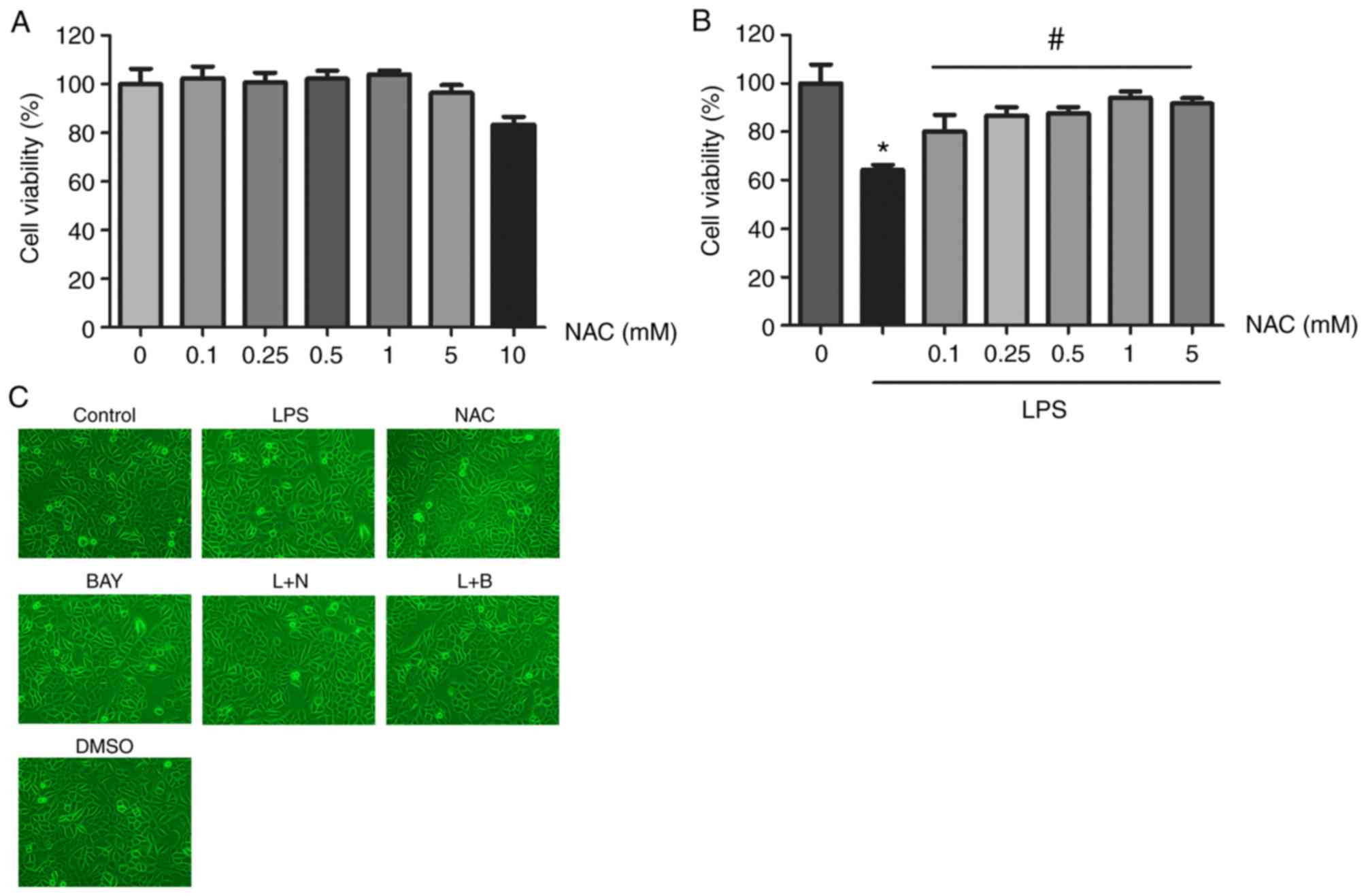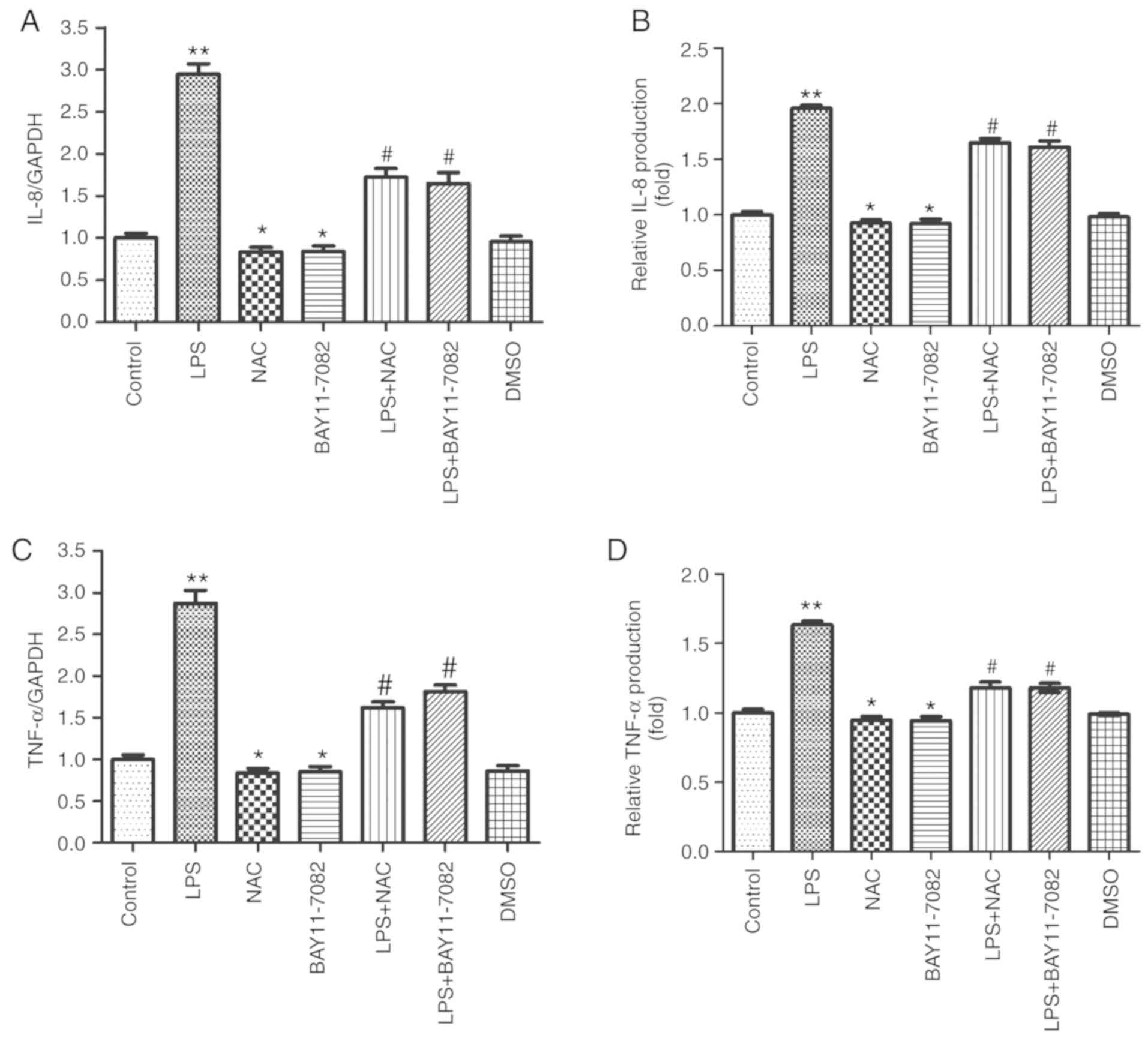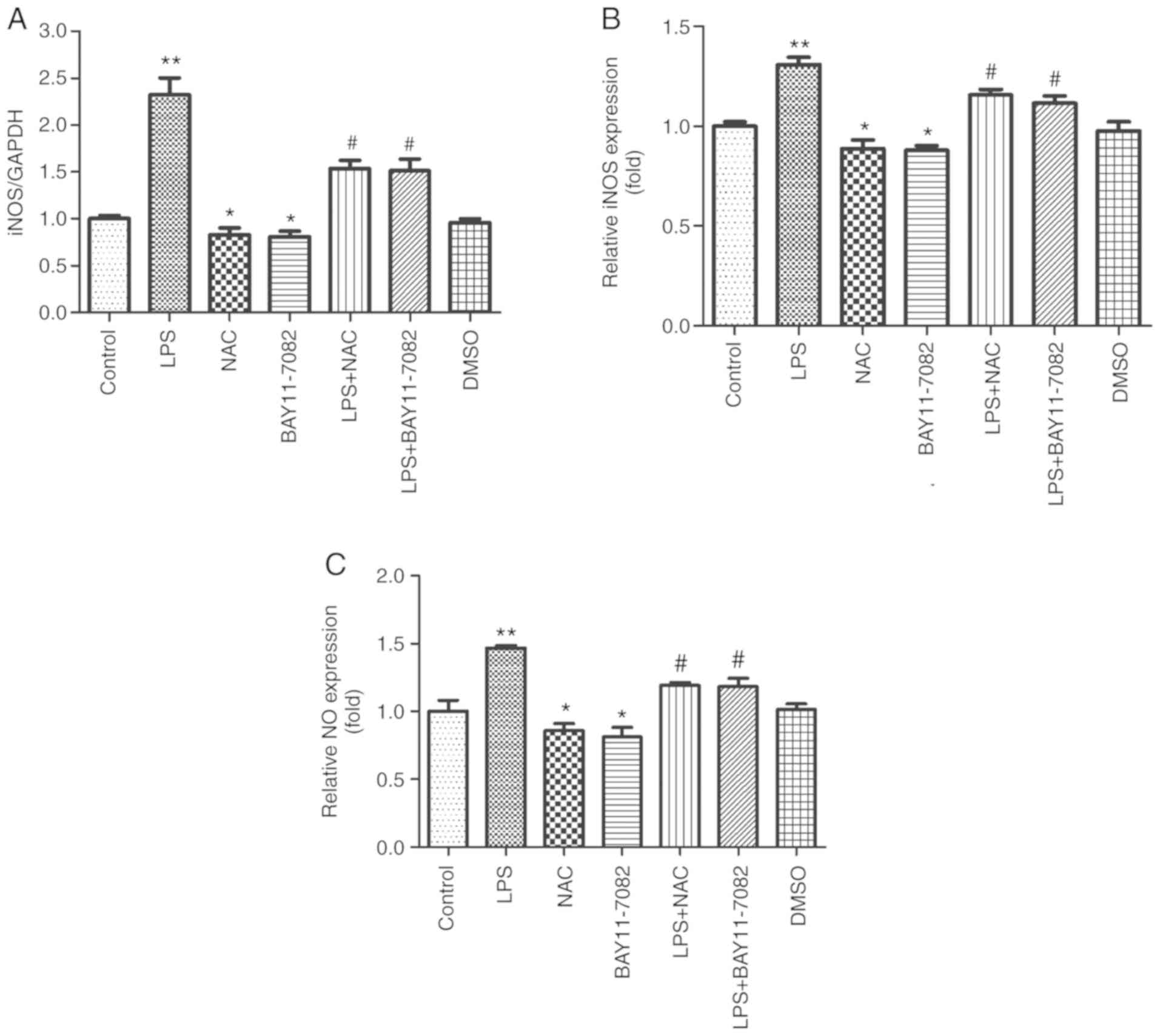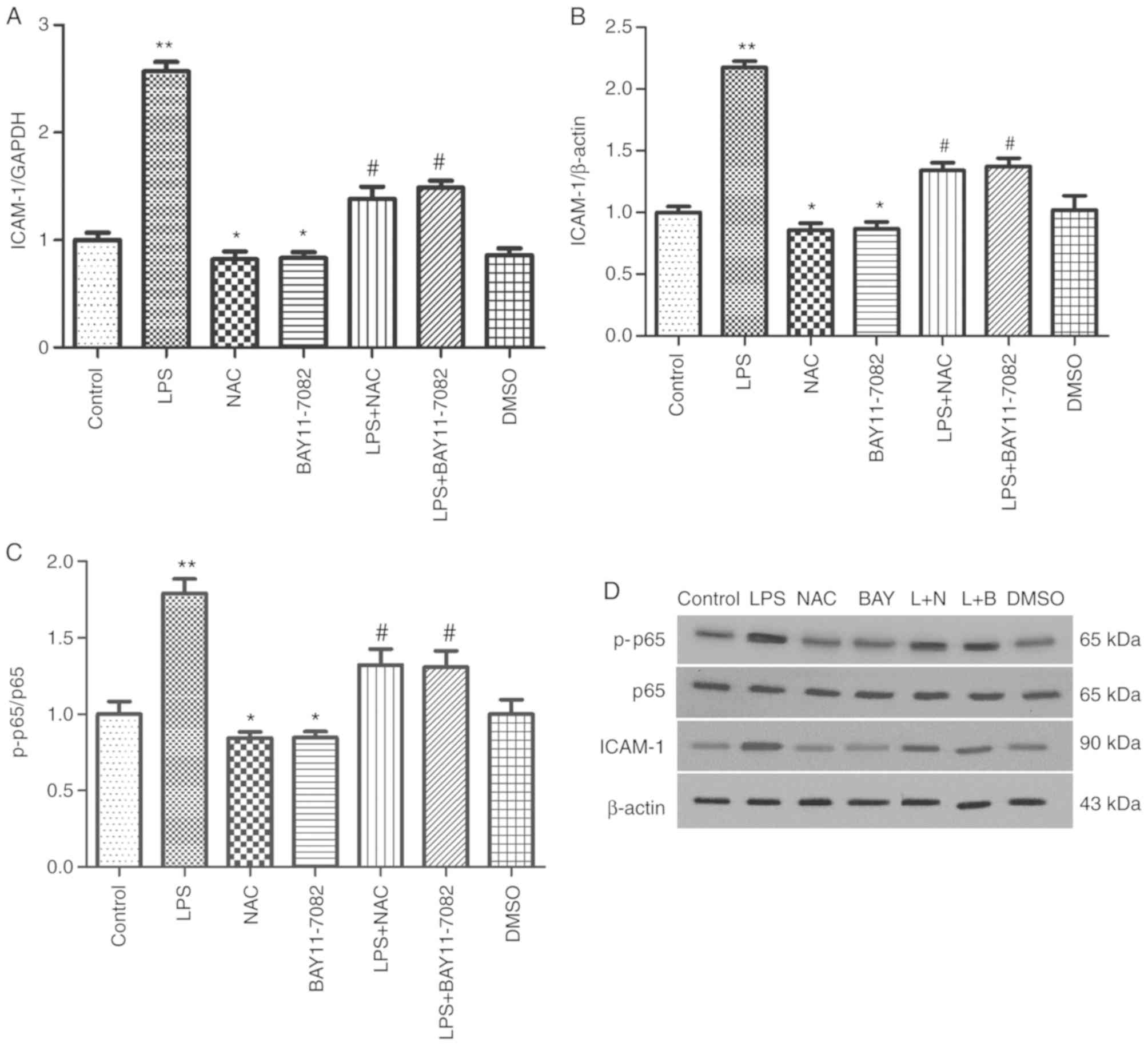|
1
|
Ku SK, Zhou W, Lee W, Han MS, Na M and Bae
JS: Anti-inflammatory effects of hyperoside in human endothelial
cells and in mice. Inflammation. 38:784–799. 2015. View Article : Google Scholar : PubMed/NCBI
|
|
2
|
Guo L, Zhang H, Li W, Zhan D and Wang M:
N-acetyl cysteine inhibits lipopolysaccharide-mediated induction of
interleukin-6 synthesis in MC3T3-E1 cells through the NF-kB
signaling pathway. Arch Oral Boil. 93:149–154. 2018. View Article : Google Scholar
|
|
3
|
Kanmani P and Kim H: Functional
capabilities of probiotic strains on attenuation of intestinal
epithelial cell inflammatory response induced by TLR4 stimuli.
Biofactors. 45:223–235. 2019. View Article : Google Scholar : PubMed/NCBI
|
|
4
|
Jung JY, Woo SM, Kim WJ, Lee BN, Nör JE,
Min KS, Choi CH, Koh JT, Lee KJ and Hwang YC: Simvastatin inhibits
the expression of inflammatory cytokines and cell adhesion
molecules induced by LPS in human dental pulp cells. Int Endod.
50:377–386. 2017. View Article : Google Scholar
|
|
5
|
Lee W and Bae JS: Anti-inflammatory
effects of aspalathin and nothofagin from rooibos (aspalathus
linearis) in vitro and in vivo. Inflammation. 38:1502–1516. 2015.
View Article : Google Scholar : PubMed/NCBI
|
|
6
|
Chen L, Li W, Qi D and Wang D: Lycium
barbarum polysaccharide protects against LPS-induced ARDS by
inhibiting apoptosis, oxidative stress, and inflammation in
pulmonary endothelial cells. Free Radic Res. 52:480–490. 2018.
View Article : Google Scholar : PubMed/NCBI
|
|
7
|
Jin L, Zhang LM, Xie KQ, Ye Y and Feng L:
Paeoniflorin suppresses the expression of intercellular adhesion
molecule-1 (ICAM-1) in endotoxin-treated human monocytic cells. Br
J Pharmacol. 164:694–703. 2011. View Article : Google Scholar : PubMed/NCBI
|
|
8
|
Guha M and Mackman N: LPS induction of
gene expression in human monocytes. Cell Signal. 13:85–94. 2001.
View Article : Google Scholar : PubMed/NCBI
|
|
9
|
Ma MM, Li Y, Liu XY, Zhu WW, Ren X, Kong
GQ, Huang X, Wang LP, Luo LQ and Wang XZ: Cyanidin-3-O-glucoside
ameliorates lipopolysaccharide-induced injury both in vivo and in
vitro suppression of NF-kappaB and MAPK pathways. Inflammation.
38:1669–1682. 2015. View Article : Google Scholar : PubMed/NCBI
|
|
10
|
Hu Y, He K and Zhu H: Chinese herbal
medicinal ingredients affect secretion of NO, IL-10, ICAM-1 and
IL-2 by endothelial cells. Immunopharmacol Immunotoxicol.
37:324–328. 2015. View Article : Google Scholar : PubMed/NCBI
|
|
11
|
Yoo H, Ku SK, Lee T and Bae JS: Orientin
inhibits HMGB1-induced inflammatory responses in HUVECs and in
murine polymicrobial sepsis. Inflammation. 37:1705–1717. 2014.
View Article : Google Scholar : PubMed/NCBI
|
|
12
|
Kim IS, Yang EJ, Shin DH, Son KH, Park HY
and Lee JS: Effect of arazyme on the lipopolysaccharideinduced
inflammatory response in human endothelial cells. Mol Med Rep.
10:1025–1029. 2014. View Article : Google Scholar : PubMed/NCBI
|
|
13
|
Zhao YD, Huang X, Yi F, Dai Z, Qian Z,
Tiruppathi C, Tran K and Zhao YY: Endothelial FoxM1 mediates bone
marrow progenitor cell-induced vascular repair and resolution of
inflammation following inflammatory lung injury. Stem Cells.
32:1855–1864. 2014. View Article : Google Scholar : PubMed/NCBI
|
|
14
|
Tsai ML, Huang HP, Hsu JD, Lai YR, Hsiao
YP, Lu FJ and Chang HR: Topical N-acetylcysteine accelerates wound
healing in vitro and in vivo via the PKC/Stat3 pathway. Int J Mol
Sci. 15:7563–7578. 2014. View Article : Google Scholar : PubMed/NCBI
|
|
15
|
Pawlowska-Goral K, Kurzeja E and Stec M:
N-acetylcysteine protects against fluoride-induced oxidative damage
in primary rat hepatocytes. Toxicol In Vitro. 27:2279–2282. 2013.
View Article : Google Scholar : PubMed/NCBI
|
|
16
|
Dinicola S, De Grazia S, Carlomagno G and
Pintucci JP: N-acetylcysteine as powerful molecule to destroy
bacterial biofilms. A systematic review. Eur Rev Med Pharmacol Sci.
18:2942–2948. 2014.PubMed/NCBI
|
|
17
|
Mokhtari V, Afsharian P, Shahhoseini M,
Kalantar SM and Moini A: A review on various uses of N-acetyl
cysteine. Cell J. 19:11–17. 2017.PubMed/NCBI
|
|
18
|
Ohnishi T, Bandow K, Kakimoto K, Kusuyama
J and Matsuguchi T: Long-time treatment by low-dose
N-acetyl-L-cysteine enhances proinflammatory cytokine expressions
in LPS-stimulated macrophages. PLoS One. 9:e872292014. View Article : Google Scholar : PubMed/NCBI
|
|
19
|
Köse SA and Nazıroğlu M: N-acetyl cysteine
reduces oxidative toxicity, apoptosis, and calcium entry through
TRPV1 channels in the neutrophils of patients with polycystic ovary
syndrome. Free Radic Res. 49:338–346. 2015. View Article : Google Scholar : PubMed/NCBI
|
|
20
|
Khatib N, Weiner Z, Ginsberg Y, Awad N and
Beloosesky R: Protective effect of N-acetyl-cysteine (NAC) in
lipopolysaccharide (LPS)-associated inflammatory response in rat
neonates. Rambam Maimonides Med J. 8:2017. View Article : Google Scholar
|
|
21
|
Beloosesky R, Ginsberg Y, Khatib N, Maravi
N, Ross MG, Itskovitz-Eldor J and Weiner Z: Prophylactic maternal
N-acetylcysteine in rats prevents maternal inflammation-induced
offspring cerebral injury shown on magnetic resonance imaging. Am J
Obstet Gynecol. 208:213.e211–216. 2013. View Article : Google Scholar
|
|
22
|
Wu XY, Luo AY, Zhou YR and Ren JH:
N-acetylcysteine reduces oxidative stress, nuclear factorkappaB
activity and cardiomyocyte apoptosis in heart failure. Mol Med Rep.
10:615–624. 2014. View Article : Google Scholar : PubMed/NCBI
|
|
23
|
Oka S, Kamata H, Kamata K, Yagisawa H and
Hirata H: N-acetylcysteine suppresses TNF-induced NF-kappaB
activation through inhibition of IkappaB kinases. FEBS Lett.
472:196–202. 2000. View Article : Google Scholar : PubMed/NCBI
|
|
24
|
Wegelin O, van Melick HHE, Hooft L, Bosch
JLHR, Reitsma HB, Barentsz JO and Somford DM: Comparing three
different techniques for magnetic resonance imaging-targeted
prostate biopsies: A systematic review of in-bore versus magnetic
resonance imaging-transrectal ultrasound fusion versus cognitive
registration. Is there a preferred technique? Eur Urol. 71:517–531.
2017.
|
|
25
|
Zha L, Chen J, Sun S, Mao L, Chu X, Deng
H, Cai J, Li X, Liu Z and Cao W: Soyasaponins can blunt
inflammation by inhibiting the reactive oxygen species-mediated
activation of PI3K/Akt/NF-κB pathway. PLoS One. 9:e1076552014.
View Article : Google Scholar : PubMed/NCBI
|
|
26
|
Renvert S and Quirynen M: Risk indicators
for peri-implantitis. A narrative review. Clin Oral Implants Res.
26 (Suppl 11):S15–S44. 2015. View Article : Google Scholar
|
|
27
|
Kinane DF, Stathopoulou PG and Papapanou
PN: Periodontal diseases. Nat Rev Dis Primers. 3:170382017.
View Article : Google Scholar : PubMed/NCBI
|
|
28
|
Yang HW, Tang XS, Tian ZW, Wang Y, Yang WY
and Hu JZ: Effects of
nano-hydroxyapatite/polyetheretherketone-coated, sandblasted,
large-grit, and acid-etched implants on inflammatory cytokines and
osseointegration in a peri-implantitis model in beagle dogs. Med
Sci Monit. 23:4601–4611. 2017. View Article : Google Scholar : PubMed/NCBI
|
|
29
|
Cines DB, Pollak ES, Buck CA, Loscalzo J,
Zimmerman GA, McEver RP, Pober JS, Wick TM, Konkle BA, Schwartz BS,
et al: Endothelial cells in physiology and in the pathophysiology
of vascular disorders. Blood. 91:3527–3561. 1998.PubMed/NCBI
|
|
30
|
Lingen MW: Role of leukocytes and
endothelial cells in the development of angiogenesis in
inflammation and wound healing. Arch Pathol Lab Med. 125:67–71.
2001.PubMed/NCBI
|
|
31
|
Wang Y, Gao Y, Yu W, Jiang Z, Qu J and Li
K: Lycopene protects against LPS-induced proinflammatory cytokine
cascade in HUVECs. Pharmazie. 68:681–684. 2013.PubMed/NCBI
|
|
32
|
Imai Y, Dobrian AD, Weaver JR, Butcher MJ,
Cole BK, Galkina EV, Morris MA, Taylor-Fishwick DA and Nadler JL:
Interaction between cytokines and inflammatory cells in islet
dysfunction, insulin resistance and vascular disease. Diabetes Obes
Metab. 15 (Suppl 3):S117–S129. 2013. View Article : Google Scholar
|
|
33
|
Giusti L, Gabriele M, Penno G, Garofolo M,
Longo V, Del Prato S, Lucchesi D and Pucci L: A fermented whole
grain prevents lipopolysaccharides-induced dysfunction in human
endothelial progenitor cells. Oxid Med Cell Longev.
2017:10262682017. View Article : Google Scholar : PubMed/NCBI
|
|
34
|
Chen G, Zhao J, Yin Y, Wang B, Liu Q, Li
P, Zhao L and Zhou H: C-type natriuretic peptide attenuates
LPS-induced endothelial activation: Involvement of p38, Akt, and
NF-kB pathways. Amino Acids. 46:2653–2663. 2014. View Article : Google Scholar : PubMed/NCBI
|
|
35
|
Lin Q, Qin X, Shi M, Qin Z, Meng Y, Qin Z
and Guo S: Schisandrin B inhibits LPS-induced inflammatory response
in human umbilical vein endothelial cells by activating Nrf2. Int
Immunopharmacol. 49:142–147. 2017. View Article : Google Scholar : PubMed/NCBI
|
|
36
|
Liu XJ, Mu E, Liang YJ, Zhang ZD and Ma
XC: High glucose enhances permeability of human pulmonary
microvascular endothelial cells by lipopolysaccharide stimulation
in vitro and effect of DDAH/NOS/NO imbalance on its pathogenesis.
Zhonghua Wei Zhong Bing Ji Jiu Yi Xue. 25:140–144. 2013.(In
Chinese). PubMed/NCBI
|
|
37
|
Tamura EK, Cecon E, Monteiro AW, Silva CL
and Markus RP: Melatonin inhibits LPS-induced NO production in rat
endothelial cells. J Pineal Res. 46:268–274. 2009. View Article : Google Scholar : PubMed/NCBI
|
|
38
|
Dong R and Zheng S: Interleukin-8: A
critical chemokine in biliary atresia. J Gastroenterol Hepatol.
30:970–976. 2015. View Article : Google Scholar : PubMed/NCBI
|
|
39
|
Wang Y, Wang W, Wang L, Wang X and Xia J:
Regulatory mechanisms of interleukin 8 production induced by tumor
necrosis factor-α in human hepatocellular carcinoma cells. J Cell
Mol Med. 16:496–506. 2012. View Article : Google Scholar : PubMed/NCBI
|
|
40
|
Ghasemi H, Ghazanfari T, Yaraee R,
Faghihzadeh S and Hassan ZM: Roles of IL-8 in ocular inflammations:
A review. Ocul Immunol Inflamm. 19:401–412. 2011. View Article : Google Scholar : PubMed/NCBI
|
|
41
|
Rossi B, Angiari S, Zenaro E, Budui SL and
Constantin G: Vascular inflammation in central nervous system
diseases: Adhesion receptors controlling leukocyte-endothelial
interactions. J Leukoc Boil. 89:539–556. 2011. View Article : Google Scholar
|
|
42
|
Alderton WK, Cooper CE and Knowles RG:
Nitric oxide synthases: Structure, function and inhibition. Biochem
J. 357:593–615. 2001. View Article : Google Scholar : PubMed/NCBI
|
|
43
|
Gunnett CA, Lund DD, McDowell AK, Faraci
FM and Heistad DD: Mechanisms of inducible nitric oxide
synthase-mediated vascular dysfunction. Arterioscler Thromb Vasc
Biol. 25:1617–1622. 2005. View Article : Google Scholar : PubMed/NCBI
|
|
44
|
Hauser B, Matejovic M and Radermacher P:
Nitric oxide, leukocytes and microvascular permeability: Causality
or bystanders? Crit Care. 12:1042008. View
Article : Google Scholar : PubMed/NCBI
|
|
45
|
Chen QZ, Fu ZD, Zhou YB, Zhou LF, Yang CT
and Li JH: N-acetyl-L-cysteine reduces the ozone-induced lung
inflammation response in mice. Sheng Li Xue Bao. 68:767–774.
2016.(In Chinese). PubMed/NCBI
|
|
46
|
Gamage AM, Lee KO and Gan YH: Effect of
oral N-acetyl cysteine supplementation in type 2 diabetic patients
on intracellular glutathione content and innate immune responses to
Burkholderia pseudomallei. Microbes Infect. 16:661–671. 2014.
View Article : Google Scholar : PubMed/NCBI
|
|
47
|
Franceschelli S, Pesce M, Ferrone A, Gatta
DM, Patruno A, Lutiis MA, Quiles JL, Grilli A, Felaco M and
Speranza L: Biological effect of licochalcone C on the regulation
of PI3K/Akt/eNOS and NF-kB/iNOS/NO signaling pathways in H9c2 cells
in response to LPS stimulation. Int J Mol Sci. 18:E6902017.
View Article : Google Scholar : PubMed/NCBI
|
|
48
|
Ghosh S, May MJ and Kopp EB: NF-kappa B
and Rel proteins: Evolutionarily conserved mediators of immune
responses. Annu Rev Immunol. 16:225–260. 1998. View Article : Google Scholar : PubMed/NCBI
|
|
49
|
Zhang H, Qin G, Liang G, Li J, Chiu I,
Barrington RA and Liu D: Suppression of complement regulatory
protein C1 inhibitor in vascular endothelial activation by
inhibiting vascular cell adhesion molecule-1 action. Biochem
Biophys Res Commun. 358:1120–1127. 2007. View Article : Google Scholar : PubMed/NCBI
|
|
50
|
He W, Qu T, Yu Q, Wang Z, Lv H, Zhang J,
Zhao X and Wang P: LPS induces IL-8 expression through TLR4, MyD88,
NF-kappaB and MAPK pathways in human dental pulp stem cells. Int
Endod J. 46:128–136. 2013. View Article : Google Scholar : PubMed/NCBI
|
|
51
|
Lockyer JM, Colladay JS, Alperin-Lea WL,
Hammond T and Buda AJ: Inhibition of nuclear factor-kappaB-mediated
adhesion molecule expression in human endothelial cells. Circ Res.
82:314–320. 1998. View Article : Google Scholar : PubMed/NCBI
|
|
52
|
Yamagami H, Yamagami S, Inoki T, Amano S
and Miyata K: The effects of proinflammatory cytokines on
cytokine-chemokine gene expression profiles in the human corneal
endothelium. Invest Ophthalmol Vis Sci. 44:514–520. 2003.
View Article : Google Scholar : PubMed/NCBI
|













